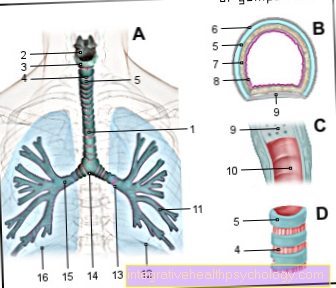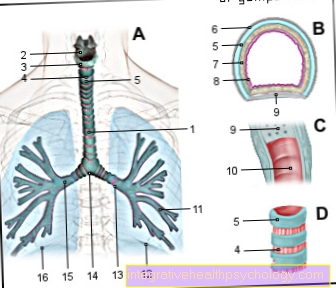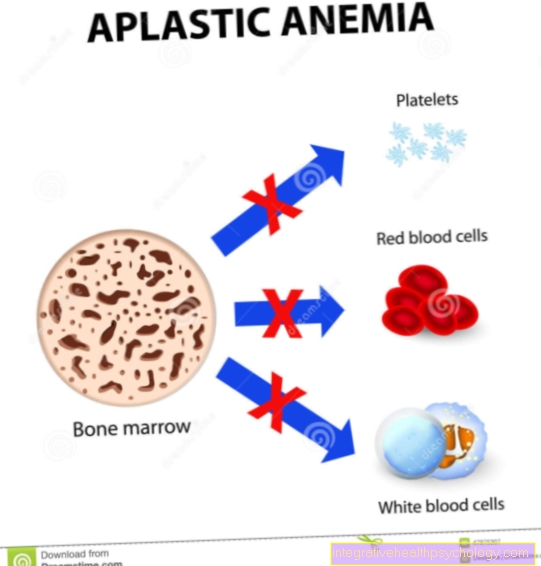Anesthetic gas
What is an anesthetic gas?
The term anesthetic gases refers to so-called inhalation anesthetics.
Strictly speaking, these are no gases at all, but rather so-called volative (volatile) anesthetics. These volative anesthetics are characterized by the fact that they evaporate even at low temperatures. This chemical property is made use of by developing special vaporizers in which the evaporation of the anesthetics can be controlled and controlled.
This is used to induce or maintain anesthesia. Only nitrous oxide and xenon are real gases that can be used for anesthesia. However, due to its severe side effects, nitrous oxide is rarely used in everyday clinical practice and xenon is currently only used experimentally.

What anesthetic gases are there?
There are a number of anesthetic gases available.Each anesthetic gas has its own advantages and disadvantages and is adapted to the patient based on this. The optimal anesthetic gas has the properties of quickly entering the body and consequently a rapid onset of action, low solubility in the blood and high solubility in fat.
At the same time, the anesthetic gas should be excreted quickly as soon as the supply is stopped at the end of the anesthesia, so that the patient wakes up again quickly. Common anesthetic gases include:
Desflurane, Sevoflurane, and Isoflurane.
Laughing gas or xenon are also used in some clinics, but are rather the exception. Older anesthetic gases such as halothane, enflurane and diethyl ether are no longer approved for clinical use.
Read more on the subject at:
- general anesthetic
- Induction of anesthesia
How do anesthetic gases work?
Anesthetic gases act on many different target structures at the molecular level. Due to their high solubility in fat, the anesthetic gases are distributed throughout the body and interact in particular with components of the cell membrane.
The exact processes on the cell membrane are not known, but it has been found that the higher the affinity of an anesthetic gas to fat-like substances, the higher the relative strength of the anesthetic gas (see Meyer-Overton correlation).
In addition to these influences on the cell membrane, anesthetic gases also have an influence on other metabolic pathways, which is why the effect is also referred to as the concept of multiple mechanisms of action and sites of action.
This includes the modification of ion channels, which are responsible for the transmission of stimuli. An effect on different receptors, such as the GABA-A receptors, 5-HT3 receptors, NMDA receptors and mACh receptors, is also discussed.
Each anesthetic gas has a different influence on the various sites of action in different ways, which is why such a wide range of effectiveness and strength comes to the fore.
What are the side effects?
Like any drug, anesthetic gases have side effects.
The general side effects include above all postoperative nausea and vomiting. Strong tremors and a feeling of coldness after gas anesthesia can also occur. Malignant hypertension is one of the most feared complications after gas anesthesia. This is a serious complication of anesthesia, which leads to muscle rigidity, palpitations and an increase in temperature due to a genetic disorder of the skeletal muscles.
Specific side effects:
- Isoflurane: Isoflurane is one of the most effective anesthetic gases and is therefore often used, but it has a very pungent odor and can irritate the mucous membranes, so it should not be used to induce anesthesia. During anesthesia, on the other hand, isoflurane has more positive side effects such as a muscle-relaxing effect and a dilation of the bronchi.
- Desflurane: Desflurane is also very irritating to the mucous membranes and therefore cannot be used to induce anesthesia. It can also lead to spasm of the larynx and bronchi. However, since Desflurane floods in and out very quickly, it is one of the most controllable anesthetic gases and is therefore very popular. Desflurane is absolutely indicated, especially in obese patients. Only large changes in concentration can lead to an increase in blood pressure and heart rate.
You may also be interested in this topic: Risks of anesthesia
What role does gas anesthesia play today?
Gas anesthesia is still one of the most important and frequently used forms of anesthesia. Gas anesthesia is particularly preferred for long operations.
A great advantage of gas anesthesia is that it can be easily controlled and monitored. During each gas anesthesia, the exact supply (inspiratory gas concentration) and the output (expiratory gas concentration) are measured.
This provides information on the concentration at the site of action, i.e. the central nervous system, and thus leads to a safe sleep without waking up phases. The positive effect on the bronchi also makes gas anesthesia a popular anesthetic method, especially for asthmatics.
Total intravenous anesthesia (TIVA) is preferred to gas anesthesia only in patients who are prone to severe postoperative nausea, who are at risk of developing malignant hypertension or who have increased intracranial pressure.
Read more on the subject at:
- Aftermath of anesthesia
- Anesthetics
Laughing gas
Laughing gas is an anesthetic gas that used to be very widespread in anesthesia and was very popular due to its hypnotic and analgesic (pain-relieving) effect.
However, laughing gas is not enough to maintain an anesthetic and must always be combined with another anesthetic gas. Due to its analgesic effect, anesthesia with nitrous oxide means that there is little need for additional pain medication.
Since laughing gas has the property of diffusing into all air-filled spaces, it is contraindicated in many procedures, for example on the intestine.
Studies have also shown that after anesthesia with nitrous oxide, patients are more prone to severe postoperative nausea and vomiting.
A serious complication can result from the end of anesthesia with nitrous oxide. Since the nitrous oxide is drained off very quickly, ventilation with pure oxygen can occur, which is toxic to the lungs and causes severe damage.
Due to the many side effects and newer, more controllable gas narcotics, nitrous oxide no longer plays a role in everyday clinical practice.
More on this: Laughing gas
xenon
Xenon is a noble gas that can also be used very well for anesthesia. Similar to nitrous oxide, it has not only a hypnotic but also an analgesic effect.
However, the side effects of xenon in clinical use have not yet been adequately clarified, which is why it has not yet been established in clinical routine and is being researched further in animal experiments.
Read more on the subject at: Types of anesthesia
What is an anesthetic gas detector?
Anesthetic gas alarms are precautionary devices that, like a fire or smoke alarm, are intended to react early to an increased concentration of various anesthetic gases in the room air.
These devices are generally not used in everyday clinical practice, since the common ventilation and anesthetic devices have appropriate devices to prevent gas leakage or to indicate it at an early stage.
However, anesthetic gas detectors are finding more and more consumers in the private sector, especially among campers and truck drivers who are afraid of being incapacitated by anesthetic gases and then being robbed.
However, the reliability of these devices is very different, as there are a number of different anesthetic gases, especially on the black market, and the calibration of the devices must be regularly adapted to the different climatic conditions.
These factors make the reliable detection of anesthetic gases very difficult.
Which anesthetic gases can be used during pregnancy and childbirth?
General anesthesia during pregnancy is always associated with a higher risk for both the mother and the unborn child.
When gas anesthesia is chosen during pregnancy, factors such as the week of pregnancy and the mother's side illnesses play a decisive role in the choice of anesthetic. In general, the newer inhalation anesthetics such as sevoflurane and desflurane are considered safe medications during pregnancy.
There are isolated studies for the volative narcotics enflurane and isoflurane, which discuss an increased incidence of cleft lip and palate after its use; a clear connection has not yet been proven.
Laughing gas is clearly contraindicated for gas anesthesia during pregnancy, as it has clearly been shown to have harmful effects on the fetus.
The noble gas xenon sounds very promising for use during pregnancy, as it is almost not metabolized in the human body and therefore should not cause any interactions in the unborn child. However, xenon has not yet been approved in everyday clinical practice and so there is still insufficient experience in use during pregnancy.
Read more on the subject at:
- Anesthesia in children
- Anesthesia during pregnancy
- birth
Is anesthetic gas heavier than air?
The anesthetic gases such as sevoflurane, desflurane and isoflurane, which are regularly used in everyday clinical practice, are lighter than air. Going there is 1.5 times heavier than air.
Gases such as chlorophore, butane or propane are also heavier than air and sink to the ground. However, this only plays a role in private use, for example in mobile homes.



-cola.jpg)

























